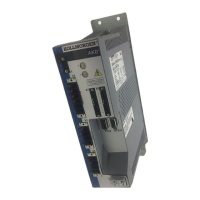6.4.6 Process Data Object (PDO)
PDOs are used for real-time data communication. PDOs can, for instance, be used to set up controllers similar
to analog drives. Instead of +/-10VDC setpoints and ROD feedback, digital speed setpoints and position feed-
back are attained via PDOs in this case.
Transmission is carried out unconfirmed without a protocol "overhead”. This communication object uses the
unconfirmed communication service.
PDOs are defined via the Object Dictionary for the AKD. Mapping is made during the configuration phase, with
the help of SDOs. Length is defined with the mapped objects.
The definition of the PDO service and protocol can be found in DS301. Examples of the usage of PDOs can be
found in the appendix.
Basically, two types of PDOs can be distinguished, depending on the direction of transmission:
l Transmit-PDOs (TPDOs) (AKD => Master)
The TPDOs transmit data from AKD to control system (for example actual value objects, instrument status).
l Receive-PDOs (RPDOs) (Master =>AKD)
The RPDOs receive data from control system to AKD (for example setpoints).
AKD supports four independent PDO channels for each direction of transmission. The channels are labeled by
the channel numbers 1 to 4.
There are two parameter sets each for the configuration of each of the four possible PDOs, and they can be set
up through the corresponding SDOs:
1.Mapping parameters, to determine which data are available (mapped) in the selected PDO and to define, which
data are contained.
2.Communication parameters, that define whether the PDOs operate in synchronized mode, or event-driven
(objects 1400h to 1403h, 1800h to 1803h).
AKD CANopen | 6 CANopen Communication Profile
Kollmorgen™ | November 2012 37

